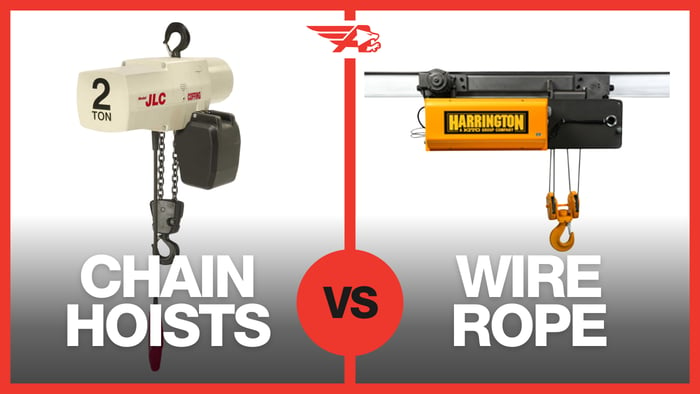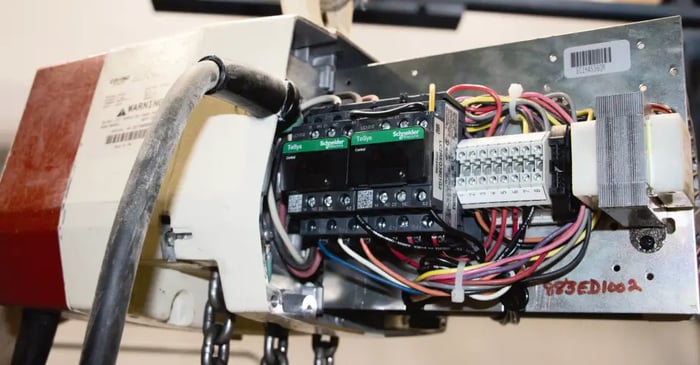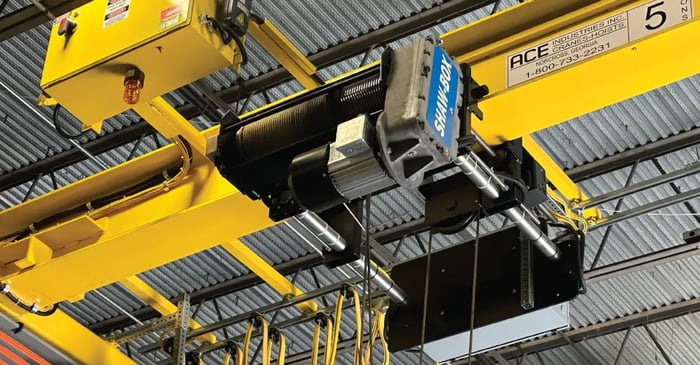
Electric Chain Hoist vs. Wire Rope Hoist: A Complete Buyer's Guide
Listen to article
Audio generated by DropInBlog's Blog Voice AI™ may have slight pronunciation nuances. Learn more
Choosing the right hoist for your lifting needs is crucial for the efficiency, safety, and longevity of your equipment and operations. When it comes to electric hoists, two primary types are often compared: the electric chain hoist and the electric wire rope hoist. Both have their unique advantages and applications, making it essential to understand their differences before making a decision.
In this comprehensive guide, we'll explore the key features, benefits, and best use cases for electric chain hoists and electric wire rope hoists, helping you determine which one is the best fit for your specific lifting requirements.
Comparison Chart: Electric Chain Hoists vs. Electric Wire Rope Hoists
Feature | ||
Best for Capacity | Up to 2 tons. | 3 tons and above. |
Cost-Effectiveness | More cost-effective for lower capacities. | More cost-effective for higher capacities. |
Headroom Requirements | Better for applications where headroom is not important. However, low-headroom options are available where space is a constraint. | Better for applications where headroom is important. Standard and low headroom options available. |
Lift Speed | Generally slower, but adequate for most lighter loads. | Faster lift speeds, ideal for heavy-duty applications. |
Durability | Modern electric chain hoists are highly durable and capable of handling frequent use in lower-capacity applications. | Wire rope is preferred for high-frequency, heavy-duty applications. |
Portability | Compact and portable; easy to move and install. | Much bigger and less portable, more suited for fixed installations. |
True Vertical Lift | Available at a lower cost. | True vertical lift available with double-reeving. |
Maintenance | Chain hoists, while also requiring maintenance, is typically less maintenance-intensive. | They typically require more maintenance due to the need for regular lubrication and inspection of the wire rope and drum. |
Typical Mounting | Hook mount is standard; lug mount available for specific needs. | Lug mount or integrated trolley available. |
Safety Features | Overload clutch standard, limit switches and load brake available. | Mechanical load brake, 2 limit switches available (geared and block). |
Environmental Considerations | Chain hoists are often preferred in harsh environments, such as those with high humidity, temperature extremes, or exposure to corrosive materials, due to their superior corrosion resistance. | Wire rope hoists are generally suited for controlled environments but can be equipped with specialized coatings or materials to withstand harsh conditions, though this may increase maintenance requirements. |
Installation & Training | Generally easier to install and operate, requiring minimal training, making them ideal for applications where simplicity and ease of use are key. | Often more complex to install and operate, particularly when equipped with advanced controls. These systems may require more extensive training and expertise to ensure safe and effective operation. |
Wire Rope Hoists: Key Features, Benefits and Applications
When Should You Choose a Wire Rope Hoist?
Electric wire rope hoists are a popular choice for many industrial applications, particularly where heavy lifting is involved. They are commonly used on bridge cranes, where the wire rope is neatly stored on a drum, presenting a clean and efficient profile. Here’s why an electric wire rope hoist might be the right choice for you:
- You need durability for frequent use: Wire rope hoists are more durable and require less frequent replacement compared to other types of hoists, making them ideal for applications involving constant or heavy use. This durability reduces downtime and maintenance costs, ensuring that your operations run smoothly with minimal interruptions.
- You need to lift heavy loads fast: Wire rope hoists are typically the go-to option for lifting capacities above 3 tons. Their ability to handle heavy loads quickly and efficiently makes them ideal for demanding industrial environments. The lift speed of wire rope hoists is generally higher, making them suitable for applications where time is critical.
- You're looking for a cost-effective hoist for higher capacities: While electric chain hoists are cost-effective for lower capacities, their cost can exceed that of wire rope hoists when dealing with loads above 3 tons. Therefore, if you’re working with heavier loads, a wire rope hoist may offer better value for money.
- You're working with a bridge crane: When installing a hoist on an electric traveling bridge crane with a capacity of 2 tons or more, wire rope hoists are generally recommended unless specific circumstances dictate the use of a chain hoist. This is due to their ability to handle large loads and the structural advantages they offer.
- You need more headroom: Especially for lifts of 20 feet and above, chain hoists can present headroom problems due to the size of the chain container. Wire rope hoists, on the other hand, typically require less headroom, making them more suitable for environments where space is a concern. In situations where even a slight hook drift could cause issues, such as lowering a load into a precise opening, a double-reeved wire rope hoist with true vertical lift is the ideal solution.
Which Wire Rope Hoist Should You Use?
Selecting the right wire rope hoist involves considering several factors to ensure it meets your specific application needs:
- Always choose a hoist with a rated capacity no greater than the structure on which it will be placed and greater than the maximum load to be lifted.
- Ensure the hoist has a duty cycle rating sufficient to handle the required job. The duty cycle refers to how often the hoist can be used within a specific time frame, typically an hour, without overheating or wearing out prematurely.
- Consider the lift required, lifting speed, operating voltage, reeving, and headroom. A motor-driven trolley is often recommended for most instances, as it provides smoother and more efficient operation.
- If redundant braking is required, or if a standard variable frequency drive (VFD) is to be used, opt for a hoist with a mechanical load brake. Additionally, a rope guide is essential if the hook block may rest on the floor or another object, as it prevents the wire rope from jumping out of the drum grooves.
Our Most Popular Wire Rope Hoists
View the rest of our best-selling Wire Rope Hoists here.
Electric Chain Hoists: What You Need To Know
Why Choose an Electric Chain Hoist
Electric chain hoists are a versatile, compact, and cost-effective solution for a wide range of lifting applications, particularly in lower-capacity scenarios. Here’s why you might opt for an electric chain hoist and the situations where they excel:
- It needs to be compact and portable: Electric chain hoists are generally smaller and more compact than wire rope hoists, making them ideal for applications where space is limited or where the hoist needs to be portable.
- You are looking for a cost-effective method for lower capacities: For capacities of 2 tons or less, chain hoists are almost always more affordable than wire rope hoists. They provide a cost-effective solution for lighter lifting tasks without compromising on performance or safety, making them an excellent choice for budget-conscious operations. They also typically have simpler mechanical designs, which can reduce both initial costs and ongoing maintenance expenses.
- You're looking for flexibility and ease of use: Electric chain hoists offer numerous configurations and speeds, particularly in lighter capacities. They are also easy to install, and the lift can be changed at any time by simply altering the chain length, making them highly adaptable to changing needs. This flexibility is crucial in operations where quick adjustments are needed to meet varying demands.
- It needs to be used in emergency applications: If you require a hoist that can be easily moved or replaced, especially in critical areas where downtime must be minimized, an electric chain hoist is the superior choice. Their portability allows for quick deployment and replacement, ensuring minimal disruption to operations.
- You require true vertical lift at a lower cost: Chain hoists provide an effective and cost-efficient solution for true vertical lift (where the load remains directly under the hoist as it is lifted, without drifting laterally). This feature is valuable for applications requiring precise load placement. However, for highly critical applications demanding the highest level of precision, wire rope hoists—particularly double-reeved systems—may offer superior control, though typically at a higher cost.
- You're working in harsh conditions: Chain hoists are often preferred in harsh environments, such as those with high humidity, temperature extremes, or exposure to corrosive materials, due to their superior corrosion resistance.
Which Electric Chain Hoist Should You Use?
Selecting the right electric chain hoist involves a careful consideration of your specific application needs. Here are our go-to rules of thumb:
- Choose a hoist with a rated capacity no greater than the structure on which it will be placed. For medium to heavy-duty applications, select a hoist with a capacity rating that is at least equal to the maximum load to be lifted and approximately 155% of the mean load.
- Opt for the highest speed available that will not compromise safety or precise load placement. For applications requiring accurate load positioning, a two-speed model is recommended.
- In most cases, a hook mount is sufficient for chain hoists. However, if additional headroom is needed, or if a motor-driven trolley will be used, a lug mount may be more appropriate.
- Consider whether a mechanical load brake is necessary for redundant safety, particularly in long lift applications. Hoists without a mechanical load brake are preferable in situations where heat buildup in the gear case must be minimized.
- Choose a three-phase model when possible, as these tend to have better duty cycles and are more dependable.
Our Most Popular Electric Chain Hoists:
View the rest of our best-selling Electric Chain Hoists Here.
Picking The Right Hoist For You - General Hoist Selection Tips
Regardless of whether you choose an electric chain hoist or an electric wire rope hoist, there are some general selection tips that apply to both:
- Consider Start/Stop Frequency: The number of starts and stops per hour directly affects the lifespan of electro-mechanical devices. Frequent starts and stops can cause heat buildup, leading to equipment damage. Two-speed motors, inverters, or modern hoists equipped with soft-start technology or Variable Frequency Drives (VFDs) can help mitigate these issues, reducing mechanical wear and extending the lifespan of the equipment.
- Account for Ball Bearing Life: Ball bearing life decreases significantly with increased load. For example, a two-ton hoist used at a mean load of one ton will have a ball bearing life eight times longer than the same hoist used steadily at its rated load. This can result in substantial savings in repairs and downtime.
- Safety Features: A limit switch is one of the most important safety features available for electric hoists. These devices shut off the hoist when the hook reaches its highest or lowest position, preventing damage or accidents. In addition to reliable limit switches, modern electric hoists often come with additional safety features like overload protection systems, further enhancing operational safety.
Contact Us To Get Personalized Advice
At Ace Industries, we offer the best selection of hoists from all major manufacturers, ensuring you get the perfect hoist for your application. Our comprehensive inventory guarantees quick delivery, competitive pricing, and the best technical and application advice. Plus, with our same-day shipments, no labor charges for modifications, and top-notch after-sales service, you can trust Ace Industries to meet all your hoisting needs.
Ready to choose the right hoist for your operation? Contact our experts today for personalized advice and a quote tailored to your specific requirements.










